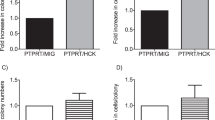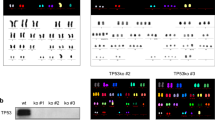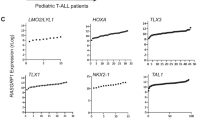Abstract
There is now good evidence that the cellular protein, p53, is involved in the transformation process, although its precise role is unknown1. It was reported recently that expression of the p53 gene can immortalize cells2 and that the p53 gene can replace the myc oncogene in a myc–ras immortalization/transformation assay3,4. We have investigated whether p53 is involved in the progression towards the neoplastic state in vivo and report here that erythroleukaemic cell lines transformed by different isolates of Friend leukaemia virus show altered expression of the cellular p53 gene. High levels of p53 protein are found in certain lines, but the protein is undetectable in others. This heterogeneity in p53 gene expression is associated with heterogeneity in tumorigenicity. We demonstrate that genomic rearrangements are responsible for p53 gene Jnactivation in these cell lines and that they occur in vivo during the natural progression of Friend virus-induced erythroleukaemia.
This is a preview of subscription content, access via your institution
Access options
Subscribe to this journal
Receive 51 print issues and online access
$199.00 per year
only $3.90 per issue
Buy this article
- Purchase on Springer Link
- Instant access to full article PDF
Prices may be subject to local taxes which are calculated during checkout
Similar content being viewed by others
References
Crawford, L. Int. Rev. exp. Path. 25, 1–50 (1983).
Jenkins, J. R., Rudge, K. & Currie, G. A. Nature 312, 651–654 (1984).
Parada, L. F., Land, H., Weinberg, R. A., Wolf, D. & Rotter, V. Nature 312, 649–651 (1984).
Eliyahn, D., Raz, A., Gruss, P., Givol, D. & Oren, M. Nature 312, 646–649 (1984).
Teich, N. et al. in RNA Tumor Viruses (eds Weiss, R., Teich, N., Varmus, H. & Coffin, J.) 857–880 (Cold Spring Harbor Laboratory, New York, 1982).
Harlow, E., Crawford, L. V., Pim, D. C. & Williamson, N. M. J. Virol. 39, 861–869 (1981).
Coffman, R. L. & Weissman, I. L. J. exp. Med. 153, 269–279 (1981).
Rotter, V., Boss, M. A. & Balimore, D. J. Virol. 38, 336–346 (1981).
Dippold, W. G., Jay, G., Deleo, A. B., Khoury, G. & Old, L. J. Proc. natn. Acad. Sci. U.S.A. 78, 1695–1699 (1981).
Gurney, E. G., Harrison, R. O. & Fenno, J. J. Virol. 34, 752–763 (1980).
Burnette, W. N. Analyt. Biochem. 112, 195–203 (1981).
Benchimol, S. et al. in Cancer Cells Vol. 2 (eds Levine, A., Topp, W., Vande Woude, G. & Watson, J. D.) 383–391 (Cold Spring Harbor Laboratory, New York, 1984).
Jenkins, J. R., Rudge, K., Redmond, S. & Wade-Evans, A. Nucleic Acids Res. 12, 5609–5626 (1984).
Zakut-Houri, R. et al. Nature 306, 594–597 (1983).
Bienz, B., Zakut-Houri, R., Givol, D. & Oren, M. EMBO J. 3, 2179–2183 (1984).
Thomas, P. S. Meth. Enzym. 100, 255–266 (1983).
Rotter, V., Abutbul, H. & Wolf, D. Int. J. Cancer 31, 315–320 (1983).
Wolf, D., Harris, N. & Rotter, V. Cell 38, 119–126 (1984).
Mager, D. L., Mak, T. W. & Bernstein, A. Proc. natn. Acad. Sci. U.S.A. 78, 1703–1707 (1981).
Mager, D. L., Mak, T. W. & Bernstein, A. Nature 288, 592–594 (1980).
Ruscetti, S. K. & Scolnick, E. M. J. Virol. 46, 1022–1026 (1983).
Wolf, D. & Rotter, V. Molec. cell. Biol. 4, 1402–1410 (1984).
MacDonald, M. E. et al. J. exp. Med. 151, 1477–1492 (1980).
Bernstein, A., Mak, T. W. & Stephenson, J. R. Cell 12, 287–294 (1977).
Oliff, A. et al. J. Virol. 33, 475–486 (1980).
Shibuya, T. & Mak, T. W. Proc. natn. Acad. Sci. U.S.A. 80, 3721–3725 (1983).
Chirgwin, J. M., Przybyla, A. E., MacDonald, R. J. & Rutter, W. J. Biochemistry 18, 5294–5299 (1979).
Mowat, M. & Bernstein, A. J. Virol. 47, 471–477 (1983).
Wahl, G. M., Stern, M. & Stark, G. R. Proc. natn. Acad. Sci. U.S.A. 76, 3683–3687 (1979).
Southern, E. J. molec. Biol. 98, 503–517 (1975).
Rigby, P. W. J., Diekmann, M., Rhodes, C. & Berg, P. J. molec. Biol. 113, 237–251 (1977).
Author information
Authors and Affiliations
Rights and permissions
About this article
Cite this article
Mowat, M., Cheng, A., Kimura, N. et al. Rearrangements of the cellular p53 gene in erythroleukaemic cells transformed by Friend virus. Nature 314, 633–636 (1985). https://doi.org/10.1038/314633a0
Received:
Accepted:
Issue Date:
DOI: https://doi.org/10.1038/314633a0
This article is cited by
-
Shifting the paradigms for tumor suppression: lessons from the p53 field
Oncogene (2021)
-
Therapeutic targeting of p53: all mutants are equal, but some mutants are more equal than others
Nature Reviews Clinical Oncology (2018)
-
The function, mechanisms, and role of the genes PTEN and TP53 and the effects of asbestos in the development of malignant mesothelioma: a review focused on the genes' molecular mechanisms
Tumor Biology (2014)
-
Biological functions of p53 isoforms through evolution: lessons from animal and cellular models
Cell Death & Differentiation (2011)
-
The history of p53
EMBO reports (2010)
Comments
By submitting a comment you agree to abide by our Terms and Community Guidelines. If you find something abusive or that does not comply with our terms or guidelines please flag it as inappropriate.



